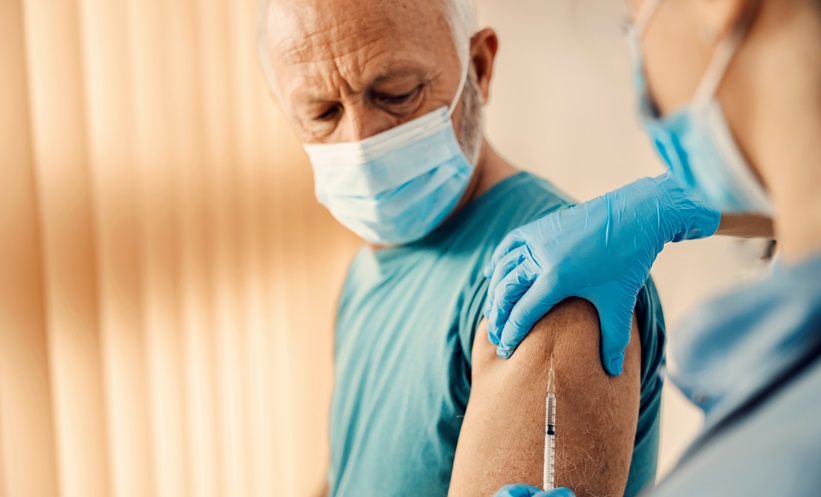Interview Summary
In the USA, there are currently three licensed COVID-19 vaccines recommended by the Centers for Disease Control and Prevention (CDC): two mRNA vaccines and a protein-based vaccine. Uptake of COVID-19 vaccines in the post-pandemic era in the USA is low, with only 22.3% of adults and 37.4% of those aged at least 65 years receiving the updated 2023–2024 COVID-19 vaccine in the last respiratory disease season. For this article, the EMJ conducted interviews in July and August 2024 with three key opinion leaders from the USA, Archana Chatterjee from Chicago Medical School and Rosalind Franklin University, North Chicago, Illinois; Chichi Ilonzo Momah from Springfield Pharmacy, Delaware County, Pennsylvania; and Stefan Gravenstein from Warren Alpert Medical School of Brown University, Providence, Rhode Island, USA, to explore the current COVID-19 vaccination landscape in the USA, and how it has changed since the height of the COVID-19 pandemic. The experts provided valuable insights into topics such as the effectiveness, reactogenicity, and safety of the current COVID-19 vaccines, waning response and durability of vaccines, heterologous boost, and the importance of surveillance strategies. Also discussed were the implementation and day-to-day challenges of COVID-19 vaccination in clinical practice. Further topics covered included the importance of educating and engaging healthcare teams to ensure a consistent, positive approach to COVID-19 vaccination across all functions in clinical practice. Finally, the experts examined approaches to address vaccine hesitancy, educate patients on COVID-19 vaccination, and improve COVID-19 vaccine uptake, and outlined what the future landscape of COVID-19 vaccination might look like.INTRODUCTION
In the USA, there are currently three licensed COVID-19 vaccines recommended by the CDC:1 two mRNA vaccines (Pfizer-BioNTech, Manhattan, New York, USA, and Moderna, Cambridge, Massachusetts, USA),2-5 and a protein-based vaccine (Novavax, Gaithersburg, Maryland, USA).6,7 Gravenstein explained that the mRNA vaccines rely on host cell machinery to translate the mRNA into the spike protein found on the surface of SARS-CoV-2, whereas the protein-based vaccine comprises copies of the spike protein and does not require host cell machinery to assemble the antigen. Momah clarified that although the mechanism of action differs according to the vaccine platform, the host immune system recognises the spike protein antigen as a foreign body following a dose of either type of vaccine and evokes an immune response. The mRNA vaccines, Pfizer-BioNTech COVID-19 Vaccine 2024–2025 Formula3 and Moderna COVID-19 Vaccine 2024–2025 Formula, are for individuals aged ≥6 months,5 and the protein-based vaccine, Novavax COVID-19 Vaccine Adjuvanted 2024–2025 Formula, is for those aged ≥12 years.6,7
Current CDC recommendations include one dose of an updated 2024–2025 COVID-19 vaccine (Pfizer-BioNTech, Moderna, or Novavax)1 to protect against serious illness from COVID-19 for everyone aged ≥5 years, with additional doses of updated COVID-19 vaccine in some individuals who are moderately or severely immunocompromised, depending on previous immunisations. Children aged 6 months–4 years may need multiple doses of COVID-19 vaccines to be up to date, including at least one dose of updated COVID-19 vaccine.
Uptake of the COVID-19 vaccine in the post-pandemic era in the USA is low, with only 22.3% of adults and 37.4% of those aged ≥65 years receiving the updated 2023–2024 COVID-19 vaccine in the last respiratory disease season.8
UNDERSTANDING THE TOOLS: VACCINE PLATFORMS, EFFECTIVENESS, AND SAFETY
Awareness of the Different Vaccine Platforms
Chatterjee described the general population as being on a spectrum of understanding about vaccine platforms, ranging from informed individuals who have a good insight to those who have little or no knowledge of the subject. According to Chatterjee, there are a lot of misunderstandings about vaccine platforms in general and COVID-19 vaccines in particular, and measures are needed to dispel this confusion.
Momah proposed that the lack of awareness of different vaccine platforms can lead to confusion, mistrust, and vaccine hesitancy, which hinder decisions and side-effect planning, ultimately impacting vaccine uptake and compliance. Momah stated that “individuals come into the clinic with a certain mindset; they may be an anti-vaxxer, or they may accept every approved vaccine; however, a lack of understanding of the different vaccine platforms hinders their decision to move forward [with vaccination].”
Gravenstein concurred that there is limited public awareness of the different vaccine platforms. In addition, one misperception that Gravenstein has heard among the general population is that mRNA vaccines lead to some kind of genetic engineering of host cells that changes human gene expression, and this worry is often not alleviated by scientific evidence to the contrary. For individuals with this persisting concern, Gravenstein suggested a protein-based vaccine may be an appropriate option.
Effectiveness, Reactogenicity, and Safety of the Current COVID-19 Vaccines
Chatterjee remarked that there are misunderstandings about COVID-19 vaccine effectiveness that arose early in the pandemic and remain today, and it is often not understood that these vaccines do not prevent infection but are highly effective at preventing the severe form of the disease (emergency department visits, hospitalisations, deaths). For example, data from the CDC show that in the week ending 17 August 2024, 2.5% of emergency department visits involved patients who were diagnosed with COVID-19, and 1.8% of all deaths in the USA were due to COVID-19.9 There were also 4.4 hospitalisations for COVID-19 per 100,000 population reported in the week ending 3 August 2024.9 Chatterjee clarified that these low rates are not solely due to COVID-19 vaccination, as natural immunity following infection is also a factor, but the overall picture is encouraging. Gravenstein mentioned that for individuals who have issues with numeracy and cannot relate to statistics about vaccination, choosing to receive COVID-19 vaccination can be likened to choosing to wear a seatbelt in a vehicle: “It does not prevent the accident, it just makes it less severe.”
Gravenstein summarised that from a safety standpoint, reactions typically seen with COVID-19 vaccination include local pain, swelling, and redness at the injection site, fatigue, headache, mild fever, nausea, and muscle pain. These side effects are usually mild-to-moderate and resolve in a few days. The proportion of vaccine recipients who report these effects is slightly higher than Gravenstein is used to seeing with influenza vaccines, but the recovery time seems to be just as quick. Also, Gravenstein noted that for the majority of recipients, side effects with the updated COVID-19 vaccines are similar to those with previous vaccines. Chatterjee added that mRNA vaccines tend to be more reactogenic than the protein-based vaccine, with local reactions and systemic reactions, such as influenza-like symptoms, fatigue, and low-grade fever, more commonly reported.
Gravenstein explained that COVID-19 vaccination can sometimes be associated with inflammation of the local draining lymph nodes, e.g., the lymph nodes in the left armpit may become inflamed following vaccination in the left arm, an effect that Gravenstein has not observed with other types of vaccines, such as the influenza vaccine. Gravenstein underlined that females who are planning to have a mammogram are advised to schedule this procedure before or several months after COVID-19 vaccination to prevent false-positive mammogram results. Gravenstein remarked that the inflammation of the lymph nodes is reversible and is more of an annoyance (e.g., for mammogram scheduling) than a serious concern, but awareness of this potential effect among healthcare professionals (HCP) will circumvent the time, cost, and worry associated with false-positive breast screening results and repeat mammograms.
Gravenstein suspected that individuals who experience the most side effects following COVID-19 vaccination will likely have the most benefit from the vaccine. Studies show that individuals with greater reactogenicity have more heightened immune responses, and those with no reactogenicity have less developed immune responses.10,11
The experts agreed that COVID-19 vaccines are an effective intervention with a good overall safety profile, and serious adverse reactions are rare.
POPULATION IMMUNITY, WANING RESPONSE AND DURABILITY, AND HETEROLOGOUS BOOST WITH COVID-19 VACCINES
Gravenstein explained that although coronaviruses have been around for a long time, a unique aspect of the COVID-19 pandemic is that the pathogen, SARS-CoV-2, was a new version of the coronavirus, and there was no population immunity associated with this virus at the start of the pandemic. This is no longer the case in the post-pandemic era as population immunity has developed; therefore, the timing of vaccination administration is now in part based on prior immunity. Gravenstein compared the COVID-19 situation with that of influenza, explaining that anyone aged over 50 years is likely to have been infected with influenza virus potentially multiple times during their lifetime, so there is no longer any “naïve moment” until there is another pandemic with a strain that is new to at least part of the population, such as the H1N1 in 2009. Gravenstein detailed that older populations had previously been exposed to this strain, so they did not get too sick, whereas, for younger populations, this was a first exposure and resulted in more widespread and severe illness. Similarly, at the beginning of the COVID-19 pandemic, no one had prior exposure to SARS-CoV-2; therefore, Gravenstein noted, the first few rounds of infection with this virus were particularly dangerous, especially in older and vulnerable individuals, because there was no population immunity.
Gravenstein clarified that immunity develops in three ways: through vaccination, infection, and a hybrid of vaccine and infections or cross-infections of other coronaviruses (which produce a low level of cross-heterotypic immunity). Protection depends on the level of exposure to both modalities. Gravenstein observed that as the population has acquired immunity during the pandemic, the lethality of SARS-CoV-2 has changed. Gravenstein further described that the vaccine produces a much higher antibody response than infection; however, the quality of the immunity is enhanced for the patient who develops hybrid immunity, i.e., acquiring immunity by both vaccination and incidental infection. COVID-19 vaccine protection wanes over time,12 and may lead to immune escape,13 when the host immune system cannot respond against an infectious agent. Although booster vaccination is an effective method to address the waning protection of vaccines and immune escape of SARS-CoV-2 variants,14 vaccine-derived immunity with the first few doses tends to be relatively short-lived; therefore, individuals who have never had COVID-19 infection potentially require several doses to develop long-lasting immunity. Gravenstein clarified that in people with weakened immune systems, the time between booster doses of vaccine has to be shortened to compensate for their lower and shorter-lived immune responses. In addition, Gravenstein pointed out that individuals can further buttress their immunity by getting the latest COVID-19 vaccine, i.e., one that best matches the most recent emerging SARS-CoV-2 variants.
The experts described that waning of the immune response over time following a dose of mRNA vaccine can be addressed using heterologous boost,14-16 also known as ‘mix and match’ vaccination, in which individuals are primed with one type of vaccine and boosted with the other (e.g., mRNA, then protein-based, or vice versa), or the two different mRNA vaccines are used to enhance the immune system. This approach could provide broader protection and increase the durability of immune protection.
Painting a picture of the post-pandemic era, Gravenstein described that the risk of infection for individuals who have never had COVID-19 is increasing because the general population is no longer taking the preventive measures mandated during the pandemic, such as wearing a mask and social distancing. Gravenstein highlighted that the benefit and value of vaccination in vulnerable populations has risen in the post-pandemic era compared with during the pandemic in the context of relaxed or non-existent preventive measures, and the consequent increased risk of infection.
THE IMPORTANCE OF SURVEILLANCE STRATEGIES
According to Momah, continuous, long-term surveillance strategies are crucial for tracking vaccine uptake and monitoring the safety and effectiveness of COVID-19 vaccines at a population level, thereby informing public health practices. Chatterjee referred to the CDC COVID-19 data tracker as a useful resource for current data on the percentage of positive tests,9 emergency department visits, hospitalisations, and deaths due to COVID-19 in the USA. In addition, public health authorities conduct wastewater surveillance,17 which indicates the levels of SARS-CoV-2 in the community and gives an early warning of viral spread and potential increases in symptomatic cases. Chatterjee noted that active surveillance strategies during the pandemic are now mostly replaced by passive surveillance. Momah emphasised that the data collected on COVID-19 are incomplete as not everyone tests or reports infection, and some HCPs do not report who has received the vaccine to the state registry, but any data that is collected can be used to inform public health policy.
PUTTING COVID-19 VACCINATION INTO PRACTICE: IMPLEMENTATION AND CHALLENGES
Implementation of COVID-19 Vaccination in the Post-pandemic Era
Chatterjee highlighted that hospital and healthcare committees, rather than HCPs, are usually responsible for selecting which vaccines are purchased and provided in a particular healthcare setting. The experts noted that the cost of the vaccine may not define which vaccine is chosen at each healthcare facility; factors such as shelf life, storage requirements, mandatory bulk ordering, availability of pre-filled syringes, delivery speed, and minimising wastage are important considerations.
Momah pointed out that the COVID-19 vaccine supply did not match the demand during the pandemic, and the general population had difficulty accessing vaccination, but now supply exceeds the demand, and there is considerable vaccine wastage. Gravenstein emphasised that access to COVID-19 vaccine, particularly for underserved populations, has greatly improved since early in the pandemic, with vaccines now available in pharmacies, healthcare centres, physicians’ offices, and mobile clinics. However, Momah summarised that although there is more than adequate vaccine supply and better access, this does not guarantee acceptance, and HCPs still need to address vaccine hesitancy, fatigue, and inequity.
The experts specified that the shelf-life and transportation of COVID-19 vaccines have improved since the early stages of the pandemic, thereby potentially reducing wastage and costs, but cost and reimbursement have not been resolved from an equity standpoint. Momah outlined that COVID-19 vaccines were provided free during the early stages of the pandemic, then were available for free through a bridge programme for individuals with no health insurance (this was a complex process for both HCPs and patients), and now vaccines are only available commercially (i.e., they are no longer free), which is an issue for uninsured and underinsured individuals.
Keeping Patients Informed about COVID-19 Vaccination
Gravenstein commented that patients can be kept informed about COVID-19 vaccination and booster scheduling via emails, healthcare web portals, and postcard reminders, with COVID-19 messaging ideally integrated with that for other respiratory viruses, such as influenza and respiratory syncytial virus, although a unified message is difficult to achieve in the context of changing recommendations.
Educating and Engaging Healthcare Teams on COVID-19 Vaccination
Momah suggested that the best way to ensure that healthcare teams are informed about and engaged with COVID-19 vaccination is to provide ongoing training and education on vaccine administration and updates to guidelines, as well as clear communication, to ensure a consistent, positive approach to vaccination across all functions in the healthcare setting. In addition, redefining roles and delegating tasks can help to address vaccine fatigue in HCPs and ancillary staff. Gravenstein stated that HCPs need to improve vaccine acceptance in patient-facing personnel and ensure that the whole healthcare team speaks with a common voice. This is particularly important in nursing homes, Gravenstein noted, where the conviction of the staff about the benefits of vaccination can translate into an increased likelihood of vaccine uptake by their residents.
Challenges at Point-of-Care for the Healthcare Professionals and their Team
Momah emphasised that HCPs must keep themselves up to date about any changes to COVID-19 vaccine recommendations to ensure that they make informed decisions on vaccination and can continue to provide optimal care and vaccine education for their patients. Furthermore, Momah underscored that managing vaccination scheduling, documentation, monitoring side effects, and reporting to the state registry creates a heavy, time-consuming workload for HCPs. Providers may decide to delegate certain tasks. The challenge then is to choose who to delegate to and their level of involvement.
In Gravenstein’s opinion, there are three major challenges for HCPs at point-of-care: deciding which vaccine to stock, anticipating the vaccine demand, and tracking who has been vaccinated and who is due for vaccination. In Rhode Island, where Gravenstein is based, some of the financial risk associated with vaccine purchase is taken by the state authority, which purchases the COVID-19 vaccine and ships it to physicians’ offices, so HCPs do not have to absorb the cost of unused doses. Most states do not have this arrangement, which means that providers may choose not to supply vaccines and instead advise their patients to get vaccinated at a pharmacy. Gravenstein explained that tracking who has received COVID-19 vaccine is difficult because there is no universal pattern, with some people getting the vaccine as soon as it is available while others delay vaccination because of a recent COVID-19 infection or other reasons. Gravenstein indicated that it is easier to vaccinate in a precise way if vaccine administration is documented properly.
Concerns Around Provider Awareness and Identification of Risk Factors for Vulnerable Populations
Chatterjee noted that people often choose to go to pharmacies for vaccination as they are more accessible than physicians’ offices or hospitals; however, pharmacy staff do not have access to a patient’s electronic medical record (EMR), so have to rely on the patient providing their medical history. This process is hampered by some patients forgetting one or more of their health conditions and events or being reluctant to divulge information about themselves. There may also be language or cultural barriers. Chatterjee highlighted that the disconnect between pharmacies and the EMR complicates risk-based assessment and impacts patient care.
Chatterjee acknowledged, “Unfortunately, we have not done a very good job of vaccinating people based on risk, although we have done a reasonably good job of vaccinating based on age…Initiatives to improve this include standing orders that automatically trigger vaccine requirements and flagging high-risk patients in the EMR.”
Gravenstein’s greatest concern regarding vulnerable populations is that they may not receive the vaccine at all. For example, patients who are immunocompromised may be reluctant to travel to an appointment because of the increased exposure to other people, and potentially the SARS-CoV-2 virus. Further barriers to vaccination in vulnerable populations include issues with access or transport, paying for the vaccine, and difficulties associated with using web portals or other technology to arrange appointments. Gravenstein indicated the advantages of having vaccines available at physicians’ office appointments to circumvent these issues and speculated that a drive-through-window vaccination approach would be ideal, but less likely to be available, in the post-pandemic era.
OVERCOMING HURDLES: VACCINE HESITANCY AND IMPROVING UPTAKE
Vaccine Hesitancy and Misinformation
According to Chatterjee, vaccine hesitancy is on a spectrum, from individuals who will never accept vaccination to those who are not at all hesitant. Chatterjee recommended that HCPs apportion time for the ‘worried well’, who are in between these two extremes of the spectrum, to answer their questions and correct misinformation, as this may be sufficient to resolve hesitancy.
Chatterjee outlined that hesitancy surrounding COVID-19 vaccines differs from that of routine vaccines, and changes temporally. Momah indicated that routine vaccines are the social norm for paediatric populations, but COVID-19 vaccination is not mandated for children in the USA, and some parents who accept routine vaccinations for their children are refusing the COVID-19 vaccine. In the experts’ experience, common reasons for hesitancy surrounding COVID-19 vaccination among patients and parents include “the pandemic is over,” “I survived the pandemic,” “this is not a severe disease,” “my immune system is strong enough,” and “children do not get sick,” and likely stem from the considerable misinformation spread about COVID-19 vaccines.18
Momah suggested that HCPs should ideally “meet people (parents) where they are” and aim to carefully introduce the concept of vaccination for their children rather than expecting to break down barriers instantly.19 Momah noted that it takes time and effort for attitudes to change, and HCPs do not necessarily have the capacity to make progress in this area.
Gravenstein described vaccine hesitancy as pervasive and explained that initial hesitancy in the early stages of the pandemic was overcome as fear of the disease increased in parallel with confidence in COVID-19 vaccines; however, there is widespread reluctance to receive vaccination in the post-pandemic era, leading to low uptake rates.8
Addressing Vaccine Hesitancy and Improving Vaccine Uptake
Momah stated that “representation matters” in vaccination strategies, with communities more likely to trust providers from a similar background. In situations where there is no such provider available, Chatterjee advocated partnering with “trusted voices in the community,” such as a spiritual or religious leader, or other authority figure, to deliver public health messages. Momah emphasised that understanding the needs of individuals in terms of background, beliefs, attitudes, values, privacy, and language as part of culturally competent care sends a positive message to the individual and their community, and helps to build trust, which may ultimately improve vaccine uptake. Furthermore, Momah acknowledged that progress in addressing vaccine hesitancy is slow; however, HCPs should continue to educate their patients and strive to alleviate the fear of vaccines.
Chatterjee mentioned that a common source of vaccine information is social media platforms,20 such as TikTok (Los Angeles, California, USA); therefore, it is important to “fight fire with fire” and provide vaccine education for target audiences via social media, where possible. Although it is a lot of work to find out which approaches and information sources resonate with different target audiences, Chatterjee is confident that this is a necessary approach to inform about the importance of vaccination and dispel the myths surrounding COVID-19 vaccines.
Gravenstein proposed that the COVID-19 vaccine should be offered through presumptive recommendation, with patients being told that they are due for a vaccination, and will receive it at the end of their routine care visit, rather than being asked whether they want the vaccine. In this way, COVID-19 vaccination becomes part of their routine care. Gravenstein suggested that healthcare teams should be aware of the benefits of vaccination, including data on decreasing hospitalisation rates with increasing rounds of vaccination, which can form part of positive messaging for patients.
According to Gravenstein, convincing people about COVID-19 vaccination requires conversations that are structured in a way that is compatible with how they learn and accept information. Uptake of COVID-19 vaccine in the post-pandemic era is low;8 therefore, novel approaches that resonate with the target audience are required. Gravenstein suggested that referring to those vaccinated in the neighbourhood or community, basing discussions on science and data, and promoting the protective effect of vaccination on the individual and their friends, family, and community may “play to the audience.”
There is limited research and evidence on the effectiveness of COVID-19 vaccine hesitancy interventions.21 Gravenstein emphasised, “A multimodal approach is needed to improve vaccine acceptance because ‘one size does not fit all’; however, a firm HCP recommendation using presumptive language is the single most important thing to improve vaccine uptake.”
FUTURE LANDSCAPE OF COVID-19 VACCINATION
Chatterjee considered that “we are going to face headwinds for a while” in the quest to improve COVID-19 vaccination rates, as the fear of disease versus the fear of the vaccine has changed, and people are no longer so concerned about being infected with the virus. Chatterjee emphasised the importance of continued education of HCPs and the public through a variety of communication methods, including social media platforms such as TikTok, and recommended that HCPs should be proactive, persistent, and patient with healthcare messaging. Chatterjee would like to see the widespread implementation of strategies that address vaccine hesitancy and combat misinformation using scientific evidence and accurate data.
Momah is hopeful that there will be better uptake of COVID-19 vaccination in the future, particularly if politics is removed from the equation as “politics and healthcare do not mix.” Momah observed that vaccination schedules for COVID-19 are beginning to resemble those for influenza, with annual boosters becoming routine practice, and it is the responsibility of HCPs to outline this connection to patients. Highlighting the concept of routine COVID-19 vaccination may help to improve uptake. Furthermore, Momah emphasised that a united front and a patient-centred approach are essential and that collaboration with pharmacies, healthcare departments, paediatricians, and other HCPs provides a valuable forum in which to share knowledge and solve problems surrounding COVID-19 vaccination.
Gravenstein suggested that widespread annual COVID-19 vaccination is a possibility in the future; however, there is not sufficient research into patient engagement, and work is needed to understand how to represent vaccines in a way that drives trust and translates into acceptance. There is a need to create public health messaging on COVID-19 vaccination that is purely based on science and public health authority value judgement and recommendations, rather than politics, as politicising the COVID-19 vaccine conversation could undermine trust in vaccine science and science as a whole. According to Gravenstein, patients may be more likely to accept different respiratory vaccines combined in a single injection rather than given separately, and combination vaccines may be available in the future. Gravenstein highlighted the convenience of a combination vaccine for patients who accept vaccination, but patients who are hesitant about one vaccine may accept another, which should then be offered separately.






